History
Etymology
The city gained its name from the Mobile tribe that the French colonists encountered living in the area ofColonial
 The European settlement of Mobile began with French colonists, who in 1702 constructed ''
The European settlement of Mobile began with French colonists, who in 1702 constructed ''19th century
 By the time Mobile was included in the
By the time Mobile was included in the 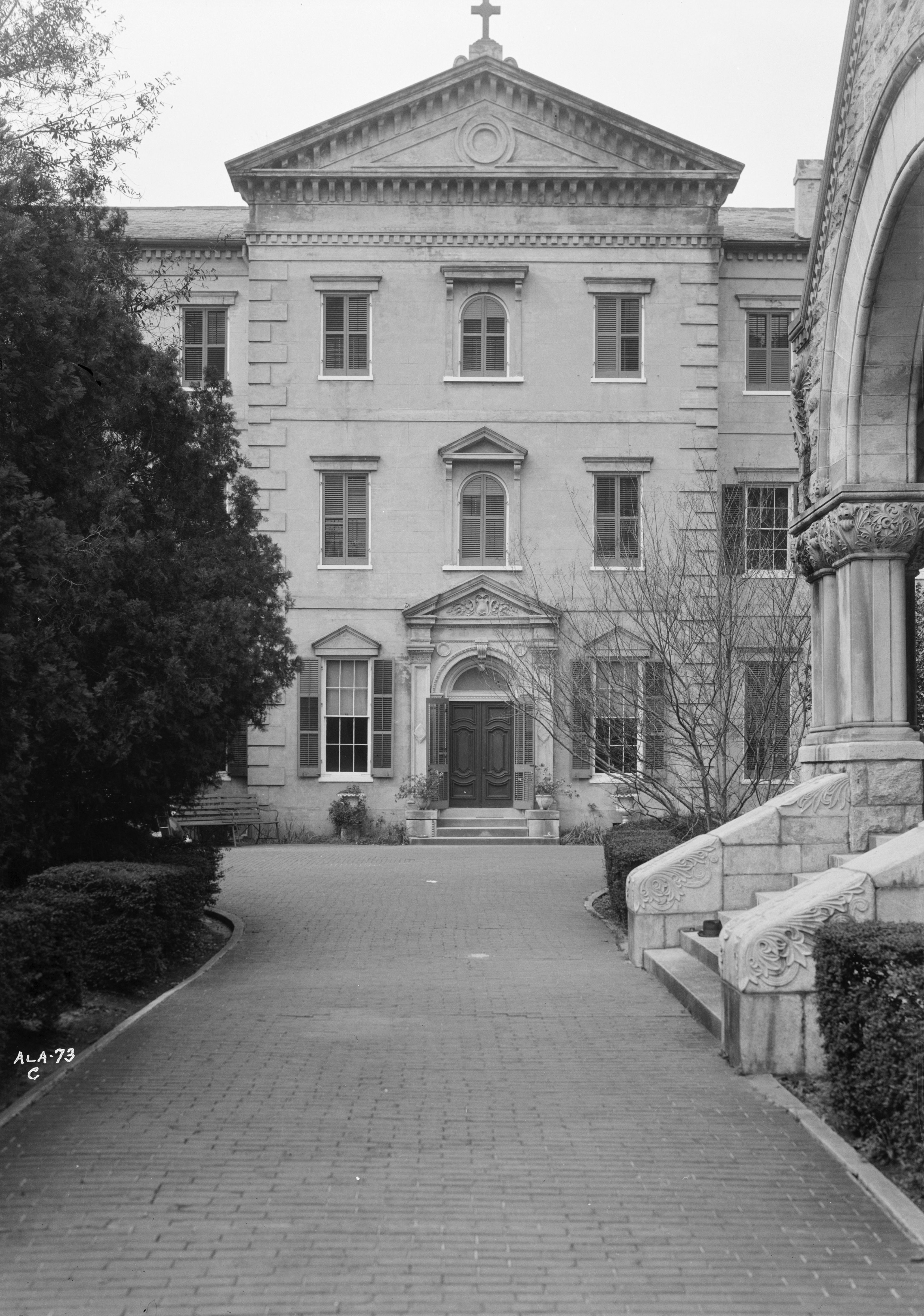 From the 1830s onward, Mobile expanded into a city of commerce with a primary focus on the cotton and slave trades. Many slaves were transported by ship in the
From the 1830s onward, Mobile expanded into a city of commerce with a primary focus on the cotton and slave trades. Many slaves were transported by ship in the  By 1853, fifty Jewish families lived in Mobile, including Philip Phillips (lawyer), Philip Phillips, an attorney from
By 1853, fifty Jewish families lived in Mobile, including Philip Phillips (lawyer), Philip Phillips, an attorney from  On May 25, 1865, the city suffered great loss when some three hundred people died as a result of an Mobile magazine explosion, explosion at a Federal government of the United States, federal ammunition depot on Beauregard Street. The explosion left a deep hole at the depot's location, and sank ships docked on the Mobile River; the resulting fires destroyed the northern portion of the city.
Federal Reconstruction era of the United States, Reconstruction in Mobile began after the Civil War and effectively ended in 1874 when the local Democratic Party (United States), Democrats gained control of the city government.Thomason, Michael. ''Mobile: the new history of Alabama's first city'', page 153. Tuscaloosa: University of Alabama Press, 2001. The last quarter of the 19th century was a time of economic depression and municipal insolvency for Mobile. One example can be provided by the value of Mobile's exports during this period of depression. The value of exports leaving the city fell from $9 million in 1878 to $3 million in 1882.Thomason, Michael. ''Mobile: the new history of Alabama's first city'', p. 145. Tuscaloosa: University of Alabama Press, 2001.
On May 25, 1865, the city suffered great loss when some three hundred people died as a result of an Mobile magazine explosion, explosion at a Federal government of the United States, federal ammunition depot on Beauregard Street. The explosion left a deep hole at the depot's location, and sank ships docked on the Mobile River; the resulting fires destroyed the northern portion of the city.
Federal Reconstruction era of the United States, Reconstruction in Mobile began after the Civil War and effectively ended in 1874 when the local Democratic Party (United States), Democrats gained control of the city government.Thomason, Michael. ''Mobile: the new history of Alabama's first city'', page 153. Tuscaloosa: University of Alabama Press, 2001. The last quarter of the 19th century was a time of economic depression and municipal insolvency for Mobile. One example can be provided by the value of Mobile's exports during this period of depression. The value of exports leaving the city fell from $9 million in 1878 to $3 million in 1882.Thomason, Michael. ''Mobile: the new history of Alabama's first city'', p. 145. Tuscaloosa: University of Alabama Press, 2001.
20th century
 The turn of the 20th century brought the Progressive Era to Mobile. The economic structure developed with new industries, generating new jobs and attracting a significant increase in population.Thomason, Michael. ''Mobile: The New History of Alabama's First City'', pages 154–169. Tuscaloosa: University of Alabama Press, 2001. The population increased from around 40,000 in 1900 to 60,000 by 1920. During this time the city received $3 million in federal grants for harbor improvements to deepen the shipping channels. During and after World War I, manufacturing became increasingly vital to Mobile's economic health, with shipbuilding and steel production being two of the most important industries.
During this time, social justice and race relations in Mobile worsened, however. The state passed a new constitution in 1901 that Disfranchisement after Reconstruction era, disenfranchised most blacks and many poor whites; and the white Democratic-dominated legislature passed other discriminatory legislation. In 1902, the city government passed Mobile's first racial segregation ordinance, segregating the city streetcars. It legislated what had been informal practice, enforced by convention. Mobile's African-American population responded to this with a two-month boycott, but the law was not repealed. After this, Mobile's ''de facto'' segregation was increasingly replaced with legislated segregation as whites imposed Jim Crow laws to maintain white supremacy, supremacy.
In 1911 the city adopted a commission form of government, which had three members elected by at-large voting. Considered to be progressive, as it would reduce the power of ward bosses, this change resulted in the elite white majority strengthening its power, as only the majority could gain election of at-large candidates. In addition, poor whites and blacks had already been disenfranchised. Mobile was one of the last cities to retain this form of government, which prevented smaller groups from electing candidates of their choice. But Alabama's white yeomanry had historically favored single-member districts in order to elect candidates of their choice.James Blacksher, Edward Still, Nick Quinton, Cullen Brown, and Royal Dumas, "Voting Rights in Alabama 1982–2006"
The turn of the 20th century brought the Progressive Era to Mobile. The economic structure developed with new industries, generating new jobs and attracting a significant increase in population.Thomason, Michael. ''Mobile: The New History of Alabama's First City'', pages 154–169. Tuscaloosa: University of Alabama Press, 2001. The population increased from around 40,000 in 1900 to 60,000 by 1920. During this time the city received $3 million in federal grants for harbor improvements to deepen the shipping channels. During and after World War I, manufacturing became increasingly vital to Mobile's economic health, with shipbuilding and steel production being two of the most important industries.
During this time, social justice and race relations in Mobile worsened, however. The state passed a new constitution in 1901 that Disfranchisement after Reconstruction era, disenfranchised most blacks and many poor whites; and the white Democratic-dominated legislature passed other discriminatory legislation. In 1902, the city government passed Mobile's first racial segregation ordinance, segregating the city streetcars. It legislated what had been informal practice, enforced by convention. Mobile's African-American population responded to this with a two-month boycott, but the law was not repealed. After this, Mobile's ''de facto'' segregation was increasingly replaced with legislated segregation as whites imposed Jim Crow laws to maintain white supremacy, supremacy.
In 1911 the city adopted a commission form of government, which had three members elected by at-large voting. Considered to be progressive, as it would reduce the power of ward bosses, this change resulted in the elite white majority strengthening its power, as only the majority could gain election of at-large candidates. In addition, poor whites and blacks had already been disenfranchised. Mobile was one of the last cities to retain this form of government, which prevented smaller groups from electing candidates of their choice. But Alabama's white yeomanry had historically favored single-member districts in order to elect candidates of their choice.James Blacksher, Edward Still, Nick Quinton, Cullen Brown, and Royal Dumas, "Voting Rights in Alabama 1982–2006"July 2006, RenewtheVRA.org, accessed March 12, 2015 The red imported fire ant was first introduced into the United States via the Port of Mobile. Sometime in the late 1930s they came ashore off cargo ships arriving from South America. The ants were carried in the soil used as ballast on those ships. They have spread throughout the South and Southwest.
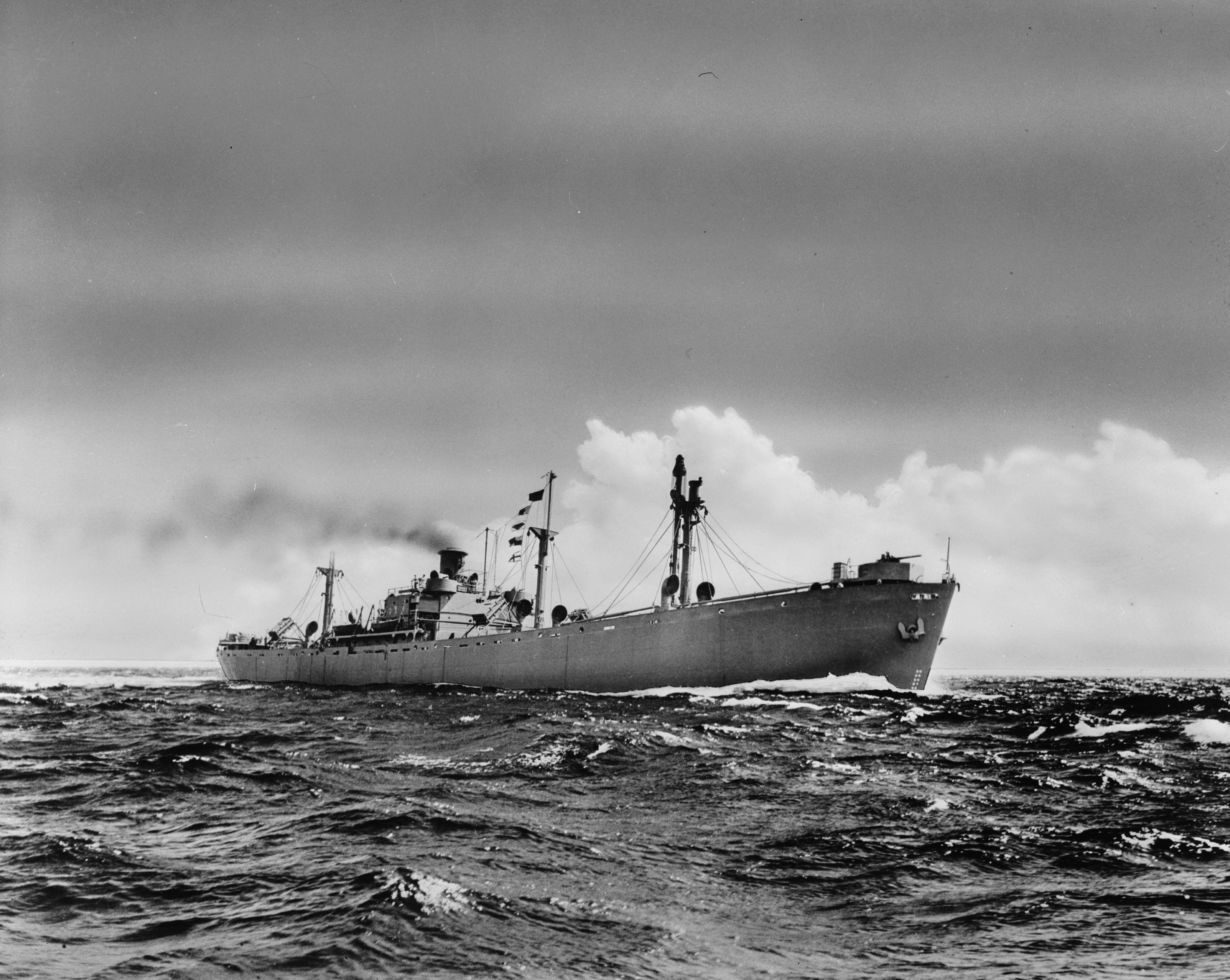
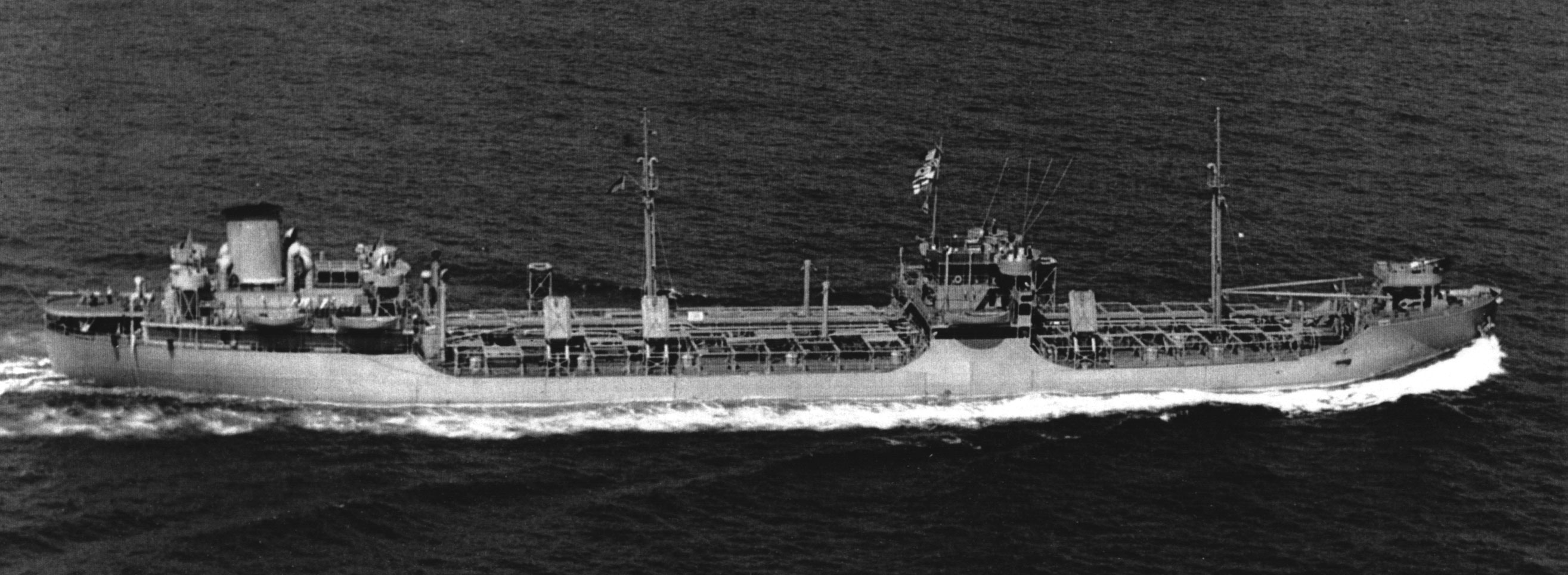 During World War II, the defense buildup in Mobile shipyards resulted in a considerable increase in the city's white middle-class and working-class population, largely due to the massive influx of workers coming to work in the shipyards and at the Brookley Air Force Base, Brookley Army Air Field.Thomason, Michael. ''Mobile: The New History of Alabama's First City'', pp. 213–217. Tuscaloosa: University of Alabama Press, 2001. Between 1940 and 1943, more than 89,000 people moved into Mobile to work for war effort industries.
Mobile was one of eighteen United States cities producing Liberty ships. Its Alabama Drydock and Shipbuilding Company (ADDSCO) supported the war effort by producing ships faster than the Axis powers of World War II, Axis powers could sink them. ADDSCO also churned out a copious number of T2 tankers for the War Department. Gulf Shipbuilding Corporation, a subsidiary of Waterman Steamship Corporation, focused on building Cargo ship, freighters, s, and Minesweeper (ship), minesweepers. The rapid increase of population in the city produced crowded conditions, increasing social tensions in the competition for housing and good jobs.
In May 1943, a race riot broke out between whites and blacks. ADDSCO management had long maintained segregated conditions at the shipyards, although the Roosevelt administration had ordered defense contractors to integrate facilities. That year ADDSCO promoted 12 blacks to positions as welders, previously reserved for whites; and whites objected to the change by rioting on May 24. The mayor appealed to the governor to call in the National Guard (United States), National Guard to restore order, but it was weeks before officials allowed African Americans to return to work.Scotty E. Kirkland, "Alabama Drydock and Shipbuilding Company (ADDSCO)"
During World War II, the defense buildup in Mobile shipyards resulted in a considerable increase in the city's white middle-class and working-class population, largely due to the massive influx of workers coming to work in the shipyards and at the Brookley Air Force Base, Brookley Army Air Field.Thomason, Michael. ''Mobile: The New History of Alabama's First City'', pp. 213–217. Tuscaloosa: University of Alabama Press, 2001. Between 1940 and 1943, more than 89,000 people moved into Mobile to work for war effort industries.
Mobile was one of eighteen United States cities producing Liberty ships. Its Alabama Drydock and Shipbuilding Company (ADDSCO) supported the war effort by producing ships faster than the Axis powers of World War II, Axis powers could sink them. ADDSCO also churned out a copious number of T2 tankers for the War Department. Gulf Shipbuilding Corporation, a subsidiary of Waterman Steamship Corporation, focused on building Cargo ship, freighters, s, and Minesweeper (ship), minesweepers. The rapid increase of population in the city produced crowded conditions, increasing social tensions in the competition for housing and good jobs.
In May 1943, a race riot broke out between whites and blacks. ADDSCO management had long maintained segregated conditions at the shipyards, although the Roosevelt administration had ordered defense contractors to integrate facilities. That year ADDSCO promoted 12 blacks to positions as welders, previously reserved for whites; and whites objected to the change by rioting on May 24. The mayor appealed to the governor to call in the National Guard (United States), National Guard to restore order, but it was weeks before officials allowed African Americans to return to work.Scotty E. Kirkland, "Alabama Drydock and Shipbuilding Company (ADDSCO)"''Encyclopedia of Alabama'' online, 2008, update August 10, 2015 In the late 1940s, the transition to the postwar economy was hard for the city, as thousands of jobs were lost at the shipyards with the decline in the defense industry. Eventually the city's social structure began to become more liberal. Replacing shipbuilding as a primary economic force, the paper and chemical industries began to expand. No longer needed for defense, most of the old military bases were converted to civilian uses. Following the war, in which many African Americans had served, veterans and their supporters stepped up activism to gain enforcement of their constitutional rights and social justice, especially in the Jim Crow South. During the 1950s the City of Mobile integrated its police force and Spring Hill College accepted students of all races. Unlike in the rest of the state, by the early 1960s the city buses and lunch counters voluntarily desegregated. The Alabama legislature passed the Cater Act in 1949, allowing cities and counties to set up industrial development boards (IDB) to issue municipal bonds as incentives to attract new industry into their local areas. The city of Mobile did not establish a Cater Act board until 1962. George E. McNally, Mobile's first Republican mayor since Reconstruction, was the driving force behind the founding of the IDB. The Mobile Area Chamber of Commerce, believing its members were better qualified to attract new businesses and industry to the area, considered the new IDB as a serious rival. After several years of political squabbling, the Chamber of Commerce emerged victorious. While McNally's IDB prompted the Chamber of Commerce to become more proactive in attracting new industry, the chamber effectively shut Mobile city government out of economic development decisions. In 1963, three African-American students brought a case against the Mobile County School Board for being denied admission to Murphy High School, Alabama, Murphy High School.Thomason (2001), ''Mobile'', pp. 260–261 This was nearly a decade after the United States Supreme Court had ruled in ''Brown v. Board of Education'' (1954) that segregation of public schools was unconstitutional. The federal district court ordered that the three students be admitted to Murphy for the 1964 school year, leading to the desegregation of Mobile County's school system. The civil rights movement gained congressional passage of the Civil Rights Act of 1964 and Voting Rights Act of 1965, which increased the percentage of black residents able to vote, ended multiple forms of segregation, and allowed the NAACP to return to Mobile. However, the city's commission form of government with at-large voting resulted in all positions being elected by the white majority, as African Americans could not command a majority for their candidates in the informally segregated city. Many forms of De_facto#Segregation, de facto segregation persisted for decades.
Geography
Neighborhoods
Mobile has a number of notable historic neighborhoods. These include Ashland Place Historic District (Mobile, Alabama), Ashland Place, Campground Historic District, Campground, Church Street East Historic District, Church Street East, De Tonti Square Historic District, De Tonti Square, Leinkauf Historic District, Leinkauf, Lower Dauphin Street Historic District, Lower Dauphin Street, Midtown Historic District (Mobile, Alabama), Midtown, Oakleigh Garden Historic District, Oakleigh Garden, Old Dauphin Way Historic District, Old Dauphin Way, Spring Hill (Mobile, Alabama), Spring Hill, and Toulminville.Climate
 Mobile's geographical location on the Gulf of Mexico provides a mild humid subtropical climate, subtropical climate (Köppen climate classification, Köppen ''Cfa''), with hot, humid summers and mild, rainy winters. The record low temperature was , set on February 13, 1899, and the record high was , set on August 29, 2000.
A 2007 study determined that Mobile is the wettest city in the contiguous 48 states, with of average annual rainfall over a 30-year period.Thompsen, Andrea (May 22, 2007)
Mobile's geographical location on the Gulf of Mexico provides a mild humid subtropical climate, subtropical climate (Köppen climate classification, Köppen ''Cfa''), with hot, humid summers and mild, rainy winters. The record low temperature was , set on February 13, 1899, and the record high was , set on August 29, 2000.
A 2007 study determined that Mobile is the wettest city in the contiguous 48 states, with of average annual rainfall over a 30-year period.Thompsen, Andrea (May 22, 2007)Study Reveals Top 10 Wettest United States Cities.
Mobile averages 120 days per year with at least of rain. Precipitation is heavy year-round. On average, July and August are the wettest months, with frequent and often-heavy shower and thunderstorm activity. October stands out as a slightly drier month than all others. Snow is rare in Mobile. The most recent snowfall event occurred January 20–22, 2025 Gulf Coast blizzard, January 21, 2025, which produced record-breaking accumulations of up to 8.5 inches within the city and near-blizzard conditions. The snowfall event previous to this one was on December 8, 2017. Mobile is occasionally affected by major tropical storms and hurricanes. The city suffered a major natural disaster on the night of September 12, 1979, when Saffir–Simpson Hurricane Scale, category-3 Hurricane Frederic passed over the heart of the city. The storm caused tremendous damage to Mobile and the surrounding area. Mobile had moderate damage from Hurricane Opal on October 4, 1995, and Hurricane Ivan on September 16, 2004. Mobile suffered millions of dollars in damage from Hurricane Katrina on August 29, 2005, which damaged much of the Gulf Coast cities. A storm surge of , topped by higher waves, damaged eastern sections of the city with extensive flooding in downtown, the Battleship Parkway, and the elevated Jubilee Parkway.
Christmas Day tornado
 In late December 2012, the city suffered two tornado hits. On December 25, 2012, at 4:54 pm, a large wedge tornado touched down in the city. The tornado rapidly intensified as it moved north-northeast at speeds of up to . The path took the tornado into Midtown Historic District (Mobile, Alabama), Midtown, causing damage or destruction to at least 100 structures. The heaviest damage to houses was along Carlen Street, Rickarby Place, Dauphin Street, Old Shell Road, Margaret Street, Silverwood Street, and Springhill Avenue.
The tornado caused significant damage to the Carmelite Monastery, Little Flower Catholic Church, commercial real estate along Airport Boulevard (Mobile, Alabama), Airport Boulevard and Government Street (Mobile, Alabama), Government Street in the Midtown at the Loop neighborhood, Murphy High School (Alabama), Murphy High School, Trinity Episcopal Church (Mobile, Alabama), Trinity Episcopal Church, Congregation Sha'arai Shomayim (Mobile, Alabama), Springhill Avenue Temple, and Mobile Infirmary Hospital before moving into the neighboring city of Prichard. The tornado was classified as an Enhanced Fujita scale, EF2 tornado by the National Weather Service on December 26.
The path taken through the city was just a short distance east of the path taken days earlier, on December 20, by an EF1 tornado which had touched down near Davidson High School (Mobile, Alabama), Davidson High School and taken a path ending in Prichard.
In late December 2012, the city suffered two tornado hits. On December 25, 2012, at 4:54 pm, a large wedge tornado touched down in the city. The tornado rapidly intensified as it moved north-northeast at speeds of up to . The path took the tornado into Midtown Historic District (Mobile, Alabama), Midtown, causing damage or destruction to at least 100 structures. The heaviest damage to houses was along Carlen Street, Rickarby Place, Dauphin Street, Old Shell Road, Margaret Street, Silverwood Street, and Springhill Avenue.
The tornado caused significant damage to the Carmelite Monastery, Little Flower Catholic Church, commercial real estate along Airport Boulevard (Mobile, Alabama), Airport Boulevard and Government Street (Mobile, Alabama), Government Street in the Midtown at the Loop neighborhood, Murphy High School (Alabama), Murphy High School, Trinity Episcopal Church (Mobile, Alabama), Trinity Episcopal Church, Congregation Sha'arai Shomayim (Mobile, Alabama), Springhill Avenue Temple, and Mobile Infirmary Hospital before moving into the neighboring city of Prichard. The tornado was classified as an Enhanced Fujita scale, EF2 tornado by the National Weather Service on December 26.
The path taken through the city was just a short distance east of the path taken days earlier, on December 20, by an EF1 tornado which had touched down near Davidson High School (Mobile, Alabama), Davidson High School and taken a path ending in Prichard.
Demographics
As of the 2020 census, there were 187,041 people, 77,772 households, and 45,953 families residing in the city. The population density was . There were 89,215 housing units. The racial makeup of the city was 40.12% White, 51.06% Black or African American, 0.27% Native American, 1.80% Asian, 0.06% Pacific Islander, and 3.13% from two or more races. Hispanic or Latino people of any race were 3.23% of the population. After annexing areas west of the city in July 2023, Mobile's population increased to 204,689 residents, making it the second-most populous city in Alabama. The annexation shifted racial demographics; Mobile became a majority-minority city with Black or African American residents remaining the largest racial group. According to American Values Atlas data published in 2014, the majority of the population were Christians, with 36% identifying as white evangelical Protestant, 18% identifying as black Protestant, 13% as mainline Protestant, and 7% as Catholic. 14% of the population identified as unaffiliated with any religion. According to the 2024 American Community Survey estimates, 19.7% of the population was under 18. The median age was 38.6. The average family size was 3.13 people. The Median income, median household income in Mobile was $50,156, while the median income for a family was $73,717. 15.2% of the population were living below the poverty line.Economy
 Aerospace, steel, ship building, retail, services, construction, medicine, and manufacturing are Mobile's major industries. After having economic decline for several decades, Mobile's economy began to rebound in the late 1980s. Between 1993 and 2003 roughly 13,983 new jobs were created as 87 new companies were founded and 399 existing companies were expanded.
Defunct companies that had been founded or based in Mobile included Alabama Drydock and Shipbuilding Company, Delchamps, and Gayfers. Current companies that were formerly based in the city include Checkers (fast food), Checkers, Konica Minolta, Minolta-QMS, Morrison Management Specialists, Morrison's, and the Waterman Steamship Corporation.
In addition to those discussed below, AlwaysHD, Foosackly's, Integrity Media, and Volkert, Inc. are headquartered in Mobile.
Aerospace, steel, ship building, retail, services, construction, medicine, and manufacturing are Mobile's major industries. After having economic decline for several decades, Mobile's economy began to rebound in the late 1980s. Between 1993 and 2003 roughly 13,983 new jobs were created as 87 new companies were founded and 399 existing companies were expanded.
Defunct companies that had been founded or based in Mobile included Alabama Drydock and Shipbuilding Company, Delchamps, and Gayfers. Current companies that were formerly based in the city include Checkers (fast food), Checkers, Konica Minolta, Minolta-QMS, Morrison Management Specialists, Morrison's, and the Waterman Steamship Corporation.
In addition to those discussed below, AlwaysHD, Foosackly's, Integrity Media, and Volkert, Inc. are headquartered in Mobile.
Major industry
Port of Mobile
Mobile's Port of Mobile, Alabama State Docks underwent the largest expansion in its history in the early 21st century. It expanded its container processing and storage facility and increased container storage at the docks by over 1,000% at a cost of over $300 million, a project completed in 2005. Despite the expansion of its container capabilities and the addition of two massive new cranes, the port went from 9th largest to the 12th largest by tonnage in the nation from 2008 to 2010.Shipyards
Shipbuilding began to make a major comeback in Mobile in 1999 with the founding of Austal USA. A subsidiary of the Australian company Austal, it expanded its production facility for United States defense and commercial aluminum shipbuilding on Blakeley Island (Alabama), Blakeley Island in 2005. Austal announced in October 2012, after winning a new defense contract and completing another building within their complex on the island, that it would expand its workforce from 3,000 to 4,500 employees. Atlantic Marine operated a major shipyard at the former Alabama Drydock and Shipbuilding Company site on Pinto Island. It was acquired by British defense conglomerate BAE Systems in May 2010 for $352 million. Doing business as BAE Systems Southeast Shipyards, the company continues to operate the site as a full-service shipyard, employing approximately 600 workers with plans to expand.Mobile Aeroplex at Brookley
The Mobile Aeroplex at Brookley is an industrial complex and airport located south of the central business district of the city. It is the largest industrial and transportation complex in the region, having more than 70 companies, many of which are aerospace, spread over . Notable employers at Brookley include Airbus North America Engineering (EADS North America, Airbus Military North America's facilities are at the Mobile Regional Airport), VT Mobile Aerospace Engineering (a division of ST Engineering), and Continental Motors, Inc., Continental Motors. Plans for an Airbus A320 family aircraft assembly plant in Mobile were formally announced by Airbus CEO Fabrice Brégier from the Mobile Convention Center on July 2, 2012. The plans include a $600 million factory at the Brookley Aeroplex for the assembly of the A319, A320 and A321 aircraft. It was planned to employ up roughly 1,000 full-time workers when fully operational. Construction began with a groundbreaking ceremony on April 8, 2013, with it becoming operable by 2015 and producing up to 50 aircraft per year by 2017. The assembly plant is the company's first factory to be built within the United States. It was announced on February 1, 2013, that Airbus had hired Alabama-based Hoar Construction to oversee construction of the facility. The factory officially opened on September 14, 2015, covering one million square feet on 53 acres of flat grassland. On October 16, 2017, Airbus announced a partnership with Bombardier Aerospace, taking over a majority share of the Bombardier CSeries airliner program. As a result of this partnership, Airbus plans to open an assembly line for CSeries aircraft in Mobile, particularly to serve the US market. This effort may allow the companies to circumvent high import tariffs on the CSeries family. The aircraft was renamed the Airbus A220 on July 10, 2018. Production started in August 2019; the first A220 from the new line is due to be delivered to Delta in the third quarter of 2020.ThyssenKrupp
German technology conglomerate ThyssenKrupp broke ground on a $4.65 billion combined stainless steel, stainless and carbon steel processing facility in Calvert, a few miles north of Mobile, in 2007. Original projections promised eventual employment for 2,700 people. The facility became operational in July 2010. The company put both its carbon mill in Calvert and a steel slab-making unit in Rio de Janeiro up for sale in May 2012, citing rising production costs and a worldwide decrease in demand. ThyssenKrupp's stainless steel division, Inoxum, including the stainless portion of the Calvert plant, was sold to Finnish stainless steel company Outokumpu, Outokumpu Oyi in 2012.Top employers
Unemployment rate
The United States Department of Labor's Bureau of Labor Statistics unemployment rate (not seasonally adjusted).Arts and culture
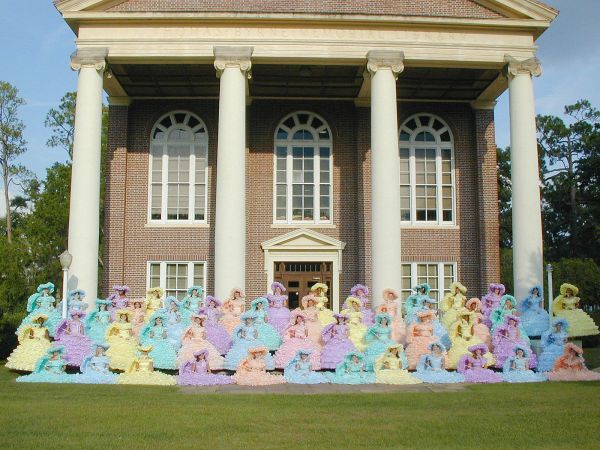 Unlike other Alabama cities, Mobile's French and Spanish colonial history has given it a culture distinguished by French, Spanish, Alabama Creole people, Creole, African, and Catholic heritage, in addition to later British and American influences. The annual
Unlike other Alabama cities, Mobile's French and Spanish colonial history has given it a culture distinguished by French, Spanish, Alabama Creole people, Creole, African, and Catholic heritage, in addition to later British and American influences. The annual LibCongress-2665
/ref> Carnival in Mobile evolved over 300 years from a sedate French Catholic tradition to a mainstream multi-week celebration. Mobile's official cultural ambassadors are the Azalea Trail Maids, meant to embody the ideals of Southern hospitality.
Carnival and Mardi Gras
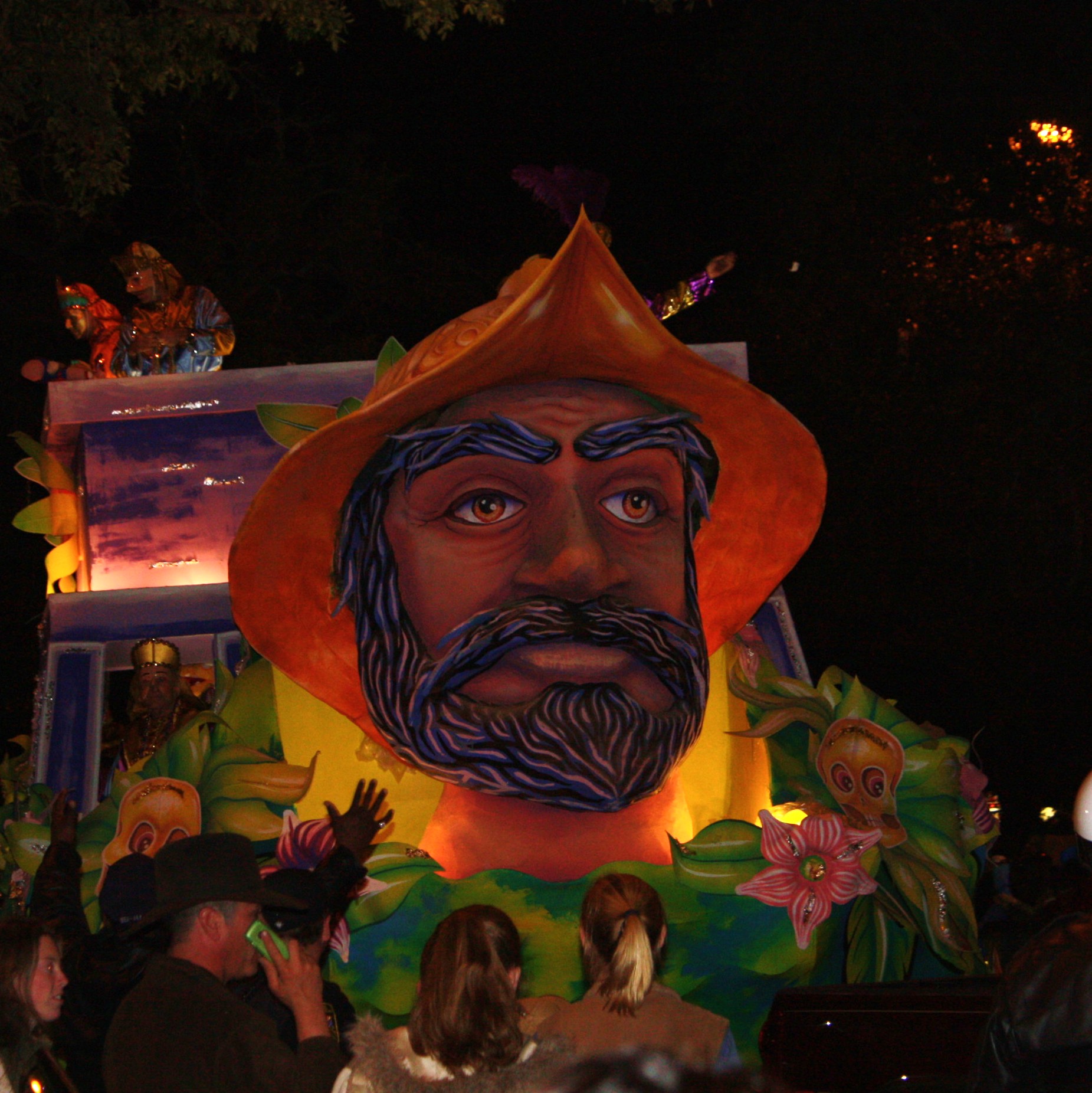 The Carnival season has expanded throughout the late fall and winter: Ball (dance), balls in the city may be scheduled as early as November, with the parades beginning after January 5 and the Twelfth Day of Christmas or Epiphany on January 6. Carnival celebrations end at midnight on
The Carnival season has expanded throughout the late fall and winter: Ball (dance), balls in the city may be scheduled as early as November, with the parades beginning after January 5 and the Twelfth Day of Christmas or Epiphany on January 6. Carnival celebrations end at midnight on  Carnival was first celebrated in Mobile in 1703 when colonial French Catholic settlers carried out their traditional celebration at the Old Mobile Site. Mobile's first Carnival society was established in 1711 with the ''Boeuf Gras Society'' (Fatted Ox Society). In 1830 Mobile's Cowbellion de Rakin Society was the first formally organized and masked mystic society in the United States to celebrate with a parade. The Cowbellions began their parade with rakes, hoes, and cowbells. They introduced horse-drawn floats in 1840. The Striker's Independent Society, formed in 1843, is the oldest surviving mystic society in the United States. Carnival celebrations were canceled during the
Carnival was first celebrated in Mobile in 1703 when colonial French Catholic settlers carried out their traditional celebration at the Old Mobile Site. Mobile's first Carnival society was established in 1711 with the ''Boeuf Gras Society'' (Fatted Ox Society). In 1830 Mobile's Cowbellion de Rakin Society was the first formally organized and masked mystic society in the United States to celebrate with a parade. The Cowbellions began their parade with rakes, hoes, and cowbells. They introduced horse-drawn floats in 1840. The Striker's Independent Society, formed in 1843, is the oldest surviving mystic society in the United States. Carnival celebrations were canceled during the Archives and libraries
 The National African American Archives and Museum features the history of African-American participation in Mardi Gras, slavery-era artifacts, and portraits and biographies of famous African Americans. The University of South Alabama Archives are open to the public and house primary sources relating to the history of the university, Mobile, and southern Alabama. The Mobile Municipal Archives contains the extant city records, dating from the Mississippi Territory period. The Mobile Genealogical Society Library and Media Center features handwritten manuscripts and published materials that are available for use in genealogical research.
The Mobile Public Library system serves Mobile and consists of eight branches across Mobile County. Its local history and genealogy division is located near the Ben E. May, Ben May Main Library on Government Street. The Saint Ignatius Archives, Museum and Theological Research Library contains primary sources, artifacts, documents, photographs and publications that pertain to the history of Saint Ignatius Church and School, the Catholic history of the city, and the history of the Roman Catholic Church.
The National African American Archives and Museum features the history of African-American participation in Mardi Gras, slavery-era artifacts, and portraits and biographies of famous African Americans. The University of South Alabama Archives are open to the public and house primary sources relating to the history of the university, Mobile, and southern Alabama. The Mobile Municipal Archives contains the extant city records, dating from the Mississippi Territory period. The Mobile Genealogical Society Library and Media Center features handwritten manuscripts and published materials that are available for use in genealogical research.
The Mobile Public Library system serves Mobile and consists of eight branches across Mobile County. Its local history and genealogy division is located near the Ben E. May, Ben May Main Library on Government Street. The Saint Ignatius Archives, Museum and Theological Research Library contains primary sources, artifacts, documents, photographs and publications that pertain to the history of Saint Ignatius Church and School, the Catholic history of the city, and the history of the Roman Catholic Church.
Arts and entertainment
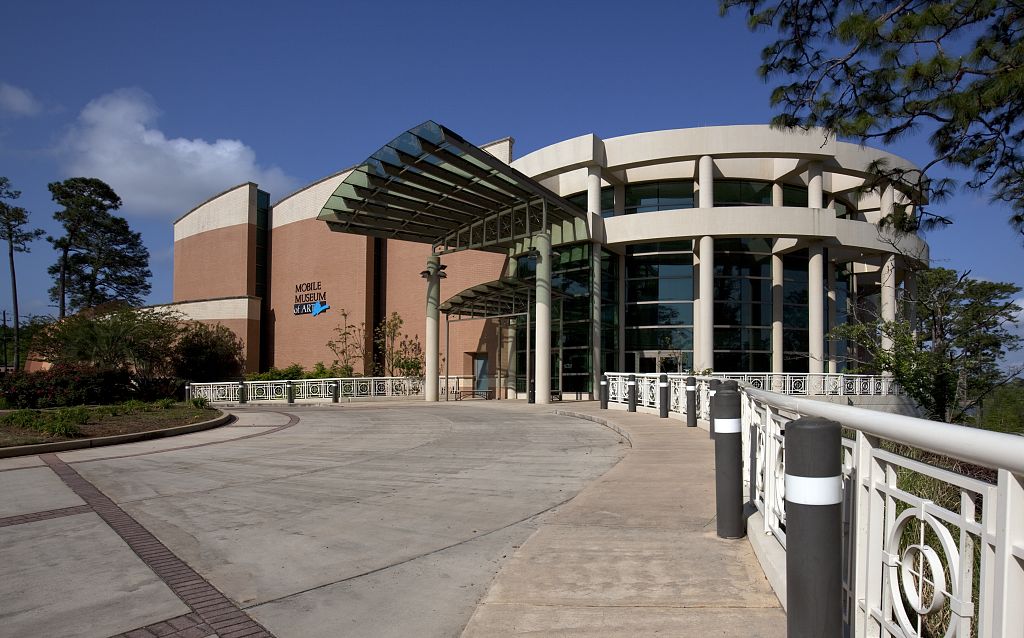 The Mobile Museum of Art features permanent exhibits that span several centuries of art and culture. The museum was expanded in 2002 to approximately . The Centre for the Living Arts is an organization that operates the historic Saenger Theatre (Mobile, Alabama), Saenger Theatre and Space 301, a contemporary art gallery. The Saenger Theatre opened in 1927 as a movie palace. Today it is a performing arts center, a small concert venue, and home to the Mobile Symphony Orchestra. The Crescent Theater in downtown Mobile has shown arthouse films since 2008.
The Mobile Museum of Art features permanent exhibits that span several centuries of art and culture. The museum was expanded in 2002 to approximately . The Centre for the Living Arts is an organization that operates the historic Saenger Theatre (Mobile, Alabama), Saenger Theatre and Space 301, a contemporary art gallery. The Saenger Theatre opened in 1927 as a movie palace. Today it is a performing arts center, a small concert venue, and home to the Mobile Symphony Orchestra. The Crescent Theater in downtown Mobile has shown arthouse films since 2008.
 The Mobile Civic Center contains three facilities under one roof. The building has an arena, a theater, and an exposition hall. It is the primary concert venue for the city and home to the Mobile Opera and Mobile Ballet. A variety of events are held at the Arthur C. Outlaw Convention Center.
The city has hosted the Greater Gulf State Fair, each October since 1955. The city hosted Bayfest (Mobile), BayFest, an annual three-day music festival, from 1995–2015. Mobile also holds the Ten Sixty Five free music festival.
The Mobile Theatre Guild is a nonprofit community theatre that has served the city since 1947. It is a member of the Mobile Arts Council, an umbrella organization for the arts in Mobile. Mobile is also host to the Joe Jefferson Players, Alabama's oldest continually running community theatre. The group debuted on December 17, 1947, and was named in honor of comedic actor Joseph Jefferson, Joe Jefferson, who spent part of his teenage years in Mobile.
The Mobile Civic Center contains three facilities under one roof. The building has an arena, a theater, and an exposition hall. It is the primary concert venue for the city and home to the Mobile Opera and Mobile Ballet. A variety of events are held at the Arthur C. Outlaw Convention Center.
The city has hosted the Greater Gulf State Fair, each October since 1955. The city hosted Bayfest (Mobile), BayFest, an annual three-day music festival, from 1995–2015. Mobile also holds the Ten Sixty Five free music festival.
The Mobile Theatre Guild is a nonprofit community theatre that has served the city since 1947. It is a member of the Mobile Arts Council, an umbrella organization for the arts in Mobile. Mobile is also host to the Joe Jefferson Players, Alabama's oldest continually running community theatre. The group debuted on December 17, 1947, and was named in honor of comedic actor Joseph Jefferson, Joe Jefferson, who spent part of his teenage years in Mobile.
Museums
Mobile is home to a variety of museums. Battleship Memorial Park is a military park on the shore of Mobile Bay. It features the World War II era battleship , the World War II era submarine , Korean War and Vietnam War Memorials, and historical military equipment. The Old City Hall (Mobile, Alabama), History Museum of Mobile showcases centuries of local history in the Old City Hall (Mobile, Alabama), Old City Hall. The Oakleigh Historic Complex (Mobile, Alabama), Oakleigh Historic Complex are three house museums that portray the daily lives of enslaved, working class, and upper class people during the 19th century. The Mobile Carnival Museum houses the city's Mardi Gras in Mobile, Mardi Gras history and memorabilia. The Bragg-Mitchell Mansion (1855), Richards DAR House (1860), and the Conde-Charlotte House, Condé-Charlotte House (1822) are antebellum architecture, antebellum house museums. The Mobile Medical Museum in the French colonial-style Vincent-Doan House chronicles the history of medicine in the city. The Phoenix Fire Museum in the restored Phoenix Volunteer Fire Company Number 6 building covers fire companies dating to 1838. The Mobile Police Department Museum chronicles the history of the city's law enforcement. The Gulf Coast Exploreum Science Center is a non-profit science center located in downtown. The Dauphin Island Sea Lab is located south of the city, on Dauphin Island near the mouth ofHistoric architecture
 Mobile has antebellum architectural examples of Greek Revival architecture, Greek Revival, Gothic Revival, Italianate architecture, Italianate, and Creole cottage. Later architectural styles in the city include the various Victorian architecture, Victorian types, Shotgun house, shotgun types, Colonial Revival architecture, Colonial Revival, Tudor Revival architecture, Tudor Revival, Spanish Colonial Revival architecture, Spanish Colonial Revival, and Beaux-Arts architecture, Beaux-Arts. The city's Historic districts in the United States, historic districts include: Old Dauphin Way Historic District, Old Dauphin Way, Oakleigh Garden Historic District, Oakleigh Garden, Lower Dauphin Street Historic District, Lower Dauphin Street, Leinkauf Historic District, Leinkauf, De Tonti Square Historic District, De Tonti Square, Church Street East Historic District, Church Street East, Ashland Place Historic District (Mobile, Alabama), Ashland Place, Campground Historic District, Campground, and Midtown Historic District (Mobile, Alabama), Midtown.
Fires in 1827 and 1839 destroyed the city's primarily wooden colonial architecture. The Cathedral Basilica of the Immaculate Conception (Mobile, Alabama), Cathedral Basilica of the Immaculate Conception was built on the colonial-era Campo Santo cemetery, of which no trace remains. Several historic cemeteries were established shortly after the colonial era. The Church Street Graveyard contains above-ground tombs and monuments spread over and was founded in 1819. The nearby Magnolia Cemetery (Mobile, Alabama), Magnolia Cemetery was established in 1836 and served as Mobile's primary burial site during the 19th and early 20th centuries. Mobile's Congregation Sha'arai Shomayim (Mobile, Alabama), Jewish community dates back to the 1820s, and the city has two historic Jewish cemetery, Jewish cemeteries, Sha'arai Shomayim Cemetery and Ahavas Chesed Cemetery. Sha'arai Shomayim is the older of the two.
Mobile has antebellum architectural examples of Greek Revival architecture, Greek Revival, Gothic Revival, Italianate architecture, Italianate, and Creole cottage. Later architectural styles in the city include the various Victorian architecture, Victorian types, Shotgun house, shotgun types, Colonial Revival architecture, Colonial Revival, Tudor Revival architecture, Tudor Revival, Spanish Colonial Revival architecture, Spanish Colonial Revival, and Beaux-Arts architecture, Beaux-Arts. The city's Historic districts in the United States, historic districts include: Old Dauphin Way Historic District, Old Dauphin Way, Oakleigh Garden Historic District, Oakleigh Garden, Lower Dauphin Street Historic District, Lower Dauphin Street, Leinkauf Historic District, Leinkauf, De Tonti Square Historic District, De Tonti Square, Church Street East Historic District, Church Street East, Ashland Place Historic District (Mobile, Alabama), Ashland Place, Campground Historic District, Campground, and Midtown Historic District (Mobile, Alabama), Midtown.
Fires in 1827 and 1839 destroyed the city's primarily wooden colonial architecture. The Cathedral Basilica of the Immaculate Conception (Mobile, Alabama), Cathedral Basilica of the Immaculate Conception was built on the colonial-era Campo Santo cemetery, of which no trace remains. Several historic cemeteries were established shortly after the colonial era. The Church Street Graveyard contains above-ground tombs and monuments spread over and was founded in 1819. The nearby Magnolia Cemetery (Mobile, Alabama), Magnolia Cemetery was established in 1836 and served as Mobile's primary burial site during the 19th and early 20th centuries. Mobile's Congregation Sha'arai Shomayim (Mobile, Alabama), Jewish community dates back to the 1820s, and the city has two historic Jewish cemetery, Jewish cemeteries, Sha'arai Shomayim Cemetery and Ahavas Chesed Cemetery. Sha'arai Shomayim is the older of the two.
Sports
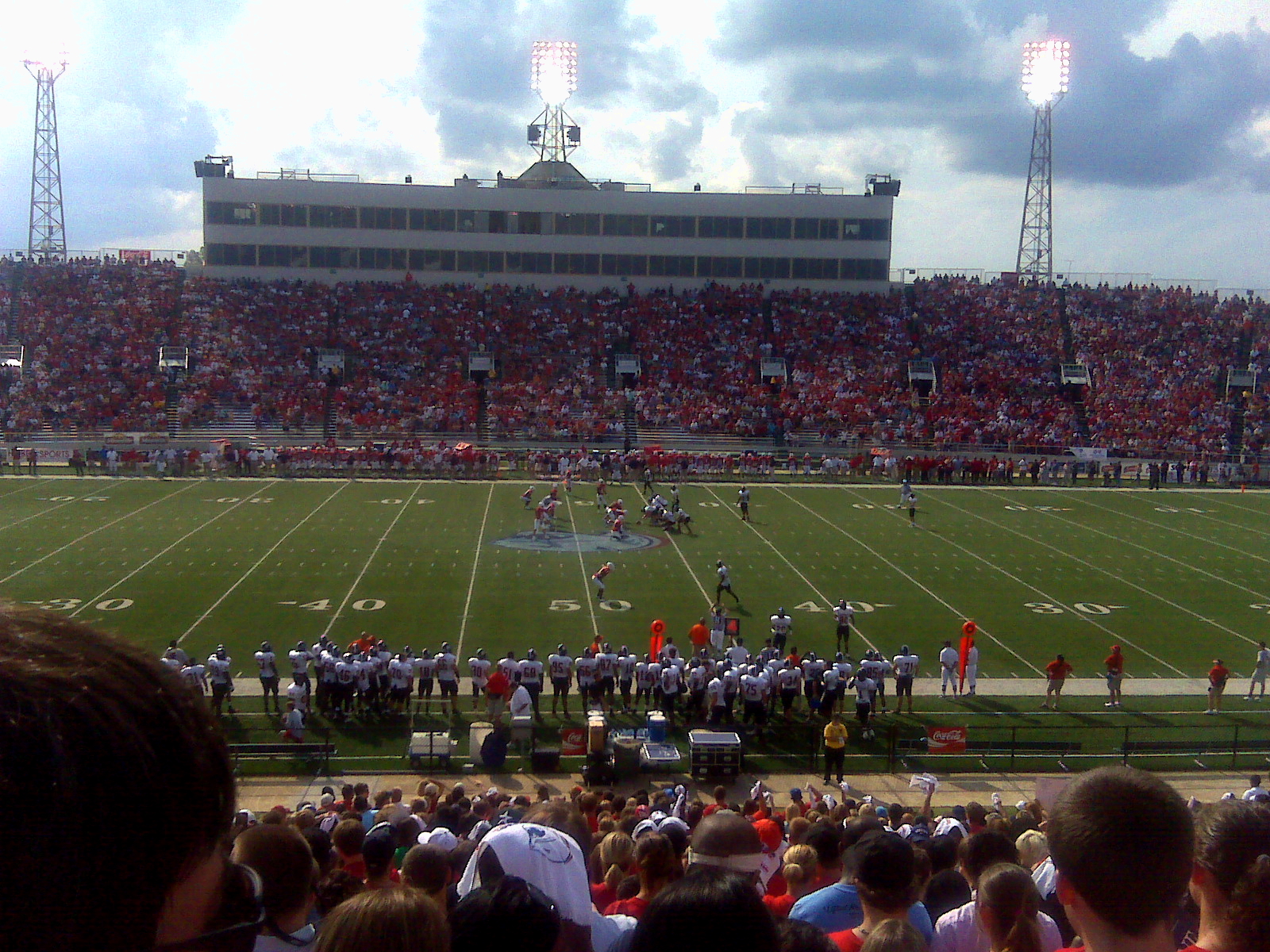
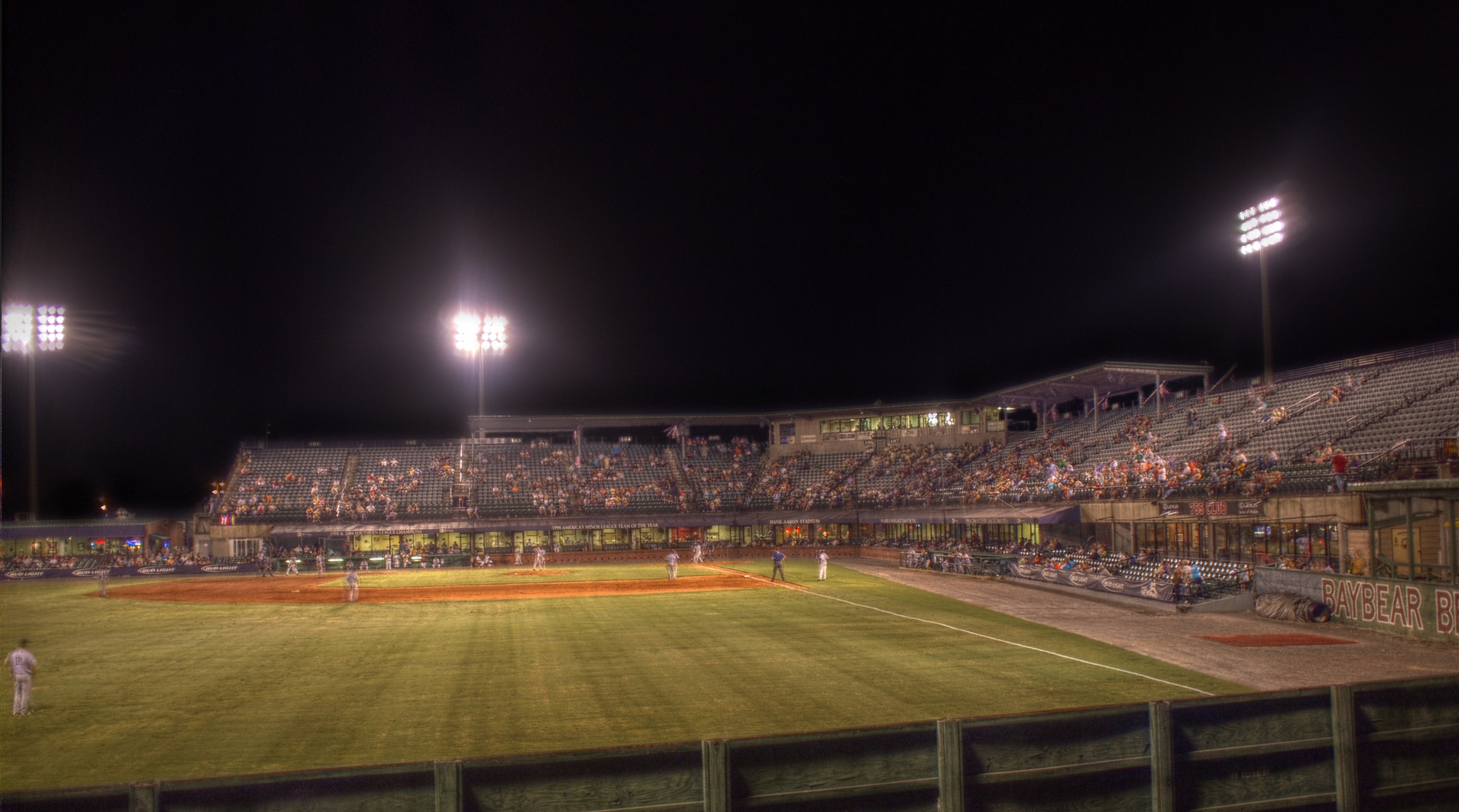

Football
Football is the most popular spectator sport in the state. Alabama has never had a top-level professional football team in the NFL, but Mobile is one of several Alabama cities with a college football tradition. Mobile has been home to the Senior Bowl since 1951, featuring the best college seniors in College football, NCAA football. Mobile is the home of two American football, football stadiums. The Ladd-Peebles Stadium opened in 1948 and has a current capacity of 40,646, making it the List of American football stadiums by capacity, fourth-largest stadium in the state. Hancock Whitney Stadium opened in 2020 on the campus of University of South Alabama and has a current capacity of 25,450. The 68 Ventures Bowl, originally known as the Mobile Alabama Bowl and later the GMAC Bowl, GoDaddy.com Bowl, Dollar General Bowl, and LendingTree Bowl, has been played at Hancock Whitney Stadium since 2021. The game was originally played at Ladd–Peebles Stadium from 1999 to 2020. It features opponents from the Sun Belt Conference, Sun Belt and Mid-American Conference, Mid-American conferences. Since 1988, Ladd–Peebles Stadium has hosted the Alabama-Mississippi All-Star Classic. The top graduating high school seniors from their respective states compete each June. The University of South Alabama in Mobile established a football team in 2007, which went undefeated in its 2009 inaugural season. Their program moved to Division I/FBS in 2013 as a member of the Sun Belt Conference. The team currently plays at Hancock Whitney Stadium, after playing at Ladd-Peebles Stadium prior to the start of the 2020 Season.Other sports and facilities
Mobile has been home to Minor League Baseball teams from the late nineteenth century to 2019. Three Southern League (1885–1899), Southern League teams operated out of Mobile intermittently in the nineteenth century: the Swamp Angels, Blackbirds, and Bluebirds. In the twentieth century, several teams, each called the Bears, operated at different times. Mobile's Hank Aaron Stadium was the home of the Minor League Mobile BayBears from 1997 to 2019. South Alabama basketball is a mid-major team in the Sun Belt Conference. They play their home games at the Mitchell Center. The Archbishop Lipscomb Athletic Complex is home of AFC Mobile, which is a National Premier Soccer League team. The public Mobile Tennis Center includes over 50 courts, all lighted and hard-court. For golfers, Magnolia Grove, part of the Robert Trent Jones Golf Trail, has 36 holes. The Falls course was recently named the best par 3 course in America. The Mitchell Company Tournament of Champions was played annually at Magnolia Grove from 1999 through 2007. The Mobile Bay LPGA Classic took its place in 2008, also held at Mobile's Magnolia Grove. Mobile is home to the Azalea Trail Run, which races through historic midtown and downtown Mobile. This 10k run has been an annual event since 1978. The Azalea Trail Run is one of the premier 10k road races in the United States, attracting runners from all over the world.Parks and recreation
 The Mobile Botanical Gardens feature a variety of flora spread over . It contains the Millie McConnell Rhododendron Garden with 1,000 evergreen and native azaleas and the Longleaf Pine Habitat. Bellingrath Gardens and Home, located on Fowl River, is a botanical garden and historic mansion that dates to the 1930s. The 5 Rivers Delta Resource Center is a facility that allows visitors to learn about and access the Mobile River, Mobile, Tensaw River, Tensaw, Apalachee River (Alabama), Apalachee, Middle River (Alabama), Middle, Blakeley River, Blakeley, and Spanish River (Alabama), Spanish rivers. It was established to serve as an easily accessible gateway to the Mobile-Tensaw River Delta. It offers boat and adventure tours, a small theater, an exhibit hall, meeting facilities, walking trails, and a canoe and kayak landing.
Mobile has more than 45 public parks within its limits, with some that are of special note. Bienville Square is a historic park in the Lower Dauphin Street Historic District. It assumed its current form in 1850 and is named for Mobile's founder, Jean-Baptiste Le Moyne, Sieur de Bienville. It was once the principal gathering place for residents, when the city was smaller, and remains popular today. Cathedral Square (Mobile, Alabama), Cathedral Square is a one-block performing arts park, also in the Lower Dauphin Street Historic District, which is overlooked by the Cathedral Basilica of the Immaculate Conception, Mobile, Cathedral Basilica of the Immaculate Conception.
The Fort of Colonial Mobile is a reconstruction of the city's original Fort Condé, built on the original fort's footprint. It serves as the official welcome center and a colonial-era living history museum. Spanish Plaza is a downtown park that honors the Spanish phase of the city between 1780 and 1813. It features the ''Arches of Friendship'', a fountain presented to Mobile by the city of Málaga, Spain. Langan (Municipal) Park, Langan Park, the largest of the parks at , features lakes, natural spaces, and contains the Mobile Museum of Art, Azalea City Golf Course, Mobile Botanical Gardens and Playhouse in the Park.
The Mobile Botanical Gardens feature a variety of flora spread over . It contains the Millie McConnell Rhododendron Garden with 1,000 evergreen and native azaleas and the Longleaf Pine Habitat. Bellingrath Gardens and Home, located on Fowl River, is a botanical garden and historic mansion that dates to the 1930s. The 5 Rivers Delta Resource Center is a facility that allows visitors to learn about and access the Mobile River, Mobile, Tensaw River, Tensaw, Apalachee River (Alabama), Apalachee, Middle River (Alabama), Middle, Blakeley River, Blakeley, and Spanish River (Alabama), Spanish rivers. It was established to serve as an easily accessible gateway to the Mobile-Tensaw River Delta. It offers boat and adventure tours, a small theater, an exhibit hall, meeting facilities, walking trails, and a canoe and kayak landing.
Mobile has more than 45 public parks within its limits, with some that are of special note. Bienville Square is a historic park in the Lower Dauphin Street Historic District. It assumed its current form in 1850 and is named for Mobile's founder, Jean-Baptiste Le Moyne, Sieur de Bienville. It was once the principal gathering place for residents, when the city was smaller, and remains popular today. Cathedral Square (Mobile, Alabama), Cathedral Square is a one-block performing arts park, also in the Lower Dauphin Street Historic District, which is overlooked by the Cathedral Basilica of the Immaculate Conception, Mobile, Cathedral Basilica of the Immaculate Conception.
The Fort of Colonial Mobile is a reconstruction of the city's original Fort Condé, built on the original fort's footprint. It serves as the official welcome center and a colonial-era living history museum. Spanish Plaza is a downtown park that honors the Spanish phase of the city between 1780 and 1813. It features the ''Arches of Friendship'', a fountain presented to Mobile by the city of Málaga, Spain. Langan (Municipal) Park, Langan Park, the largest of the parks at , features lakes, natural spaces, and contains the Mobile Museum of Art, Azalea City Golf Course, Mobile Botanical Gardens and Playhouse in the Park.
Government
Education
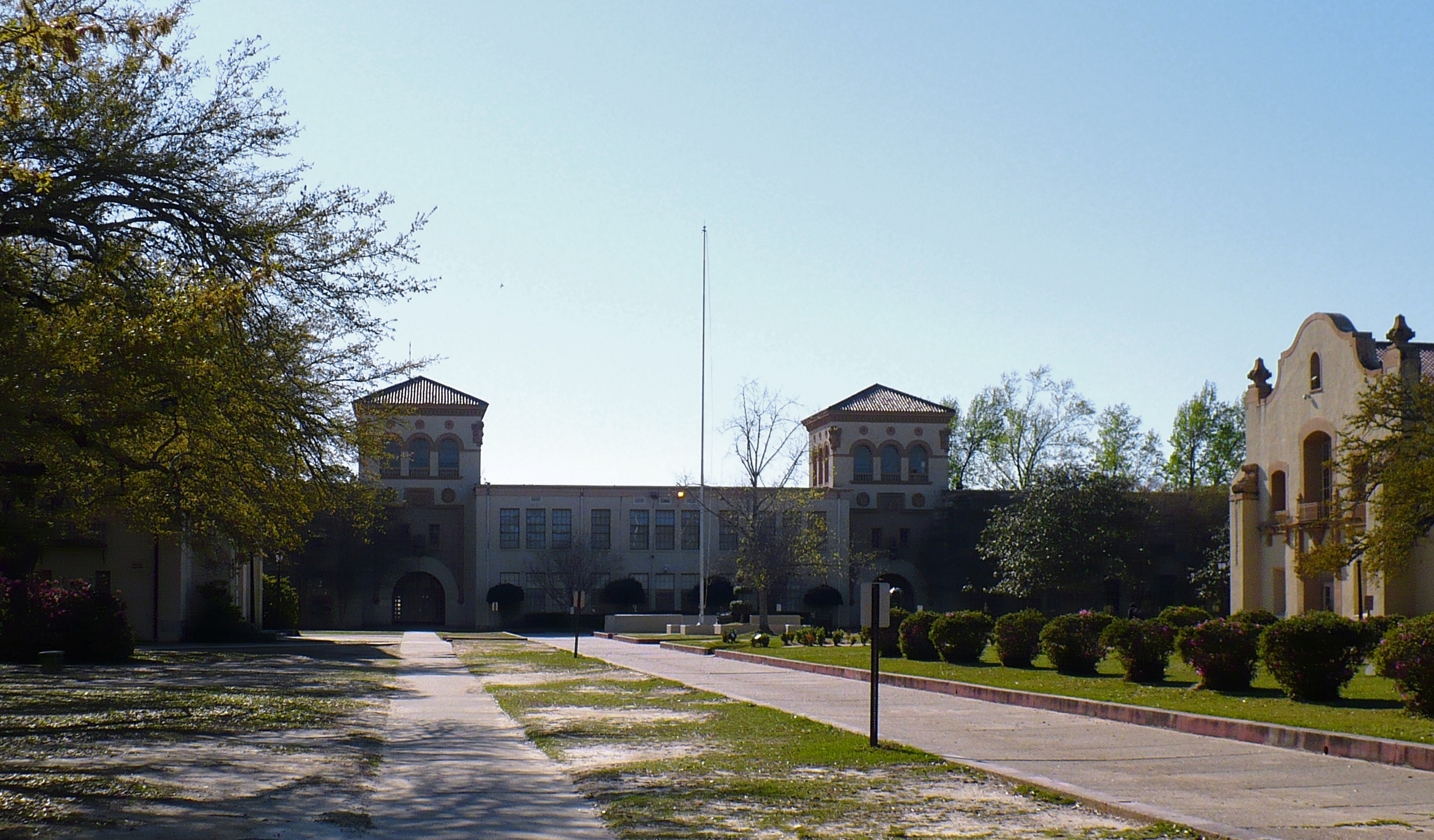

Public schools
Public schools in Mobile are operated by the Mobile County Public School System. The Mobile County Public School System has an enrollment of approximately 55,200 students at 88 schools, employs approximately 7,026 public school employees, and had a budget in 2020–2021 of $623 million. The State of Alabama operates the Alabama School of Mathematics and Science on Dauphin Street in Mobile, which boards advanced Alabama high school students. It was founded in 1989 to identify, challenge, and educate future leaders.Private and parochial schools
UMS-Wright Preparatory School is an independent co-educational university-preparatory school, preparatory school. It assumed its current configuration in 1988, when the University Military School (founded 1893) and the Julius T. Wright School for Girls (1923) merged to form UMS-Wright. Many parochial schools belong to the Roman Catholic Archdiocese of Mobile. These include McGill-Toolen Catholic High School (1896), Corpus Christi School, Little Flower Catholic School (1934), Most Pure Heart of Mary Catholic School (1900), Saint Dominic School (1961), Saint Ignatius School (1952), Saint Mary Catholic School (1867), Saint Pius X Catholic School (1957), and Saint Vincent DePaul Catholic School (1976). Notable Protestant schools include St. Paul's Episcopal School (1947), Mobile Christian School (1961), St. Lukes Episcopal School (1961), Cottage Hill Baptist School System (1961), Faith Academy (Mobile, Alabama), Faith Academy (1967), and Trinity Lutheran School (1955).Tertiary
Major colleges and universities in Mobile that are accredited by the Southern Association of Colleges and Schools include the University of South Alabama, Spring Hill College, the University of Mobile, Faulkner University, and Bishop State Community College.Undergraduate and postgraduate
The University of South Alabama is a public, Doctorate, doctoral-level university established in 1963. The university is composed of the College of Arts and Sciences, the Mitchell College of Business, the College of Education, the College of Engineering, the College of Medicine, the Doctor of Pharmacy Program, the College of Nursing, the School of Computing, and the School of Continuing Education and Special Programs. Faulkner University is a four-year private Churches of Christ, Church of Christ-affiliated university based in Montgomery, Alabama. The Mobile campus was established in 1975 and offers bachelor's degrees in Business Administration, Management of Human Resources, and Criminal Justice. It also offers associate degrees in Business Administration, Business Information Systems, Computer & Information Science, Criminal Justice, Informatics, Legal Studies, Arts, and Science. Spring Hill College, chartered in 1830, was the first Catholic college in the southeastern United States and is the third oldest Society of Jesus, Jesuit college in the country. This four-year private college offers graduate programs in Business Administration, Education, Liberal Arts, Nursing (MSN), and Theological Studies. Undergraduate divisions and programs include the Division of Business, the Communications/Arts Division, International Studies, Inter-divisional Studies, the Language and Literature Division, Bachelor of Science in Nursing, Philosophy and Theology, Political Science, the Sciences Division, the Social Sciences Division, and the Teacher Education Division. The University of Mobile is a four-year private Baptist-affiliated university in the neighboring city of Prichard that was founded in 1961.Community college
Bishop State Community College, founded in 1927, is a public, Historically black colleges and universities, historically African American, Community colleges in the United States, community college. Bishop State has four campuses in Mobile.Vocational
Several post-secondary Vocational education, vocational institutions have a campus in Mobile. These include the Alabama Institute of Real Estate, American Academy of Hypnosis, Bealle School of Real Estate, Charles Academy of Beauty Culture, Fortis College, Virginia College, ITT Technical Institute, Remington College and White and Sons Barber College.Media
NH-Register
. The paper focuses on Mobile County, Alabama, Mobile and Baldwin County, Alabama, Baldwin counties and the city of Mobile, but also serves southwestern Alabama and southeastern Mississippi. Mobile's alternative newspaper is the ''Lagniappe (newspaper), Lagniappe''. The Mobile area's local magazine is ''Mobile Bay Monthly''. The ''Mobile Beacon'' was an alternative focusing on Mobile's African-American communities that ran from 1943 to 2018. Mod Mobilian is a website with a focus on cultured living in Mobile.
Television
Mobile is served locally by a number of over-the-air television stations. These include WKRG, WKRG 5 (CBS), WALA, WALA 10 (Fox Broadcasting Company, Fox), WPMI-TV, WPMI 15 (NBC), WMPV-TV, WMPV 21 (religious broadcasting, religious), WDPM-DT, WDPM 23 (religious), Alabama Public Television, WEIQ 42 (PBS), and WFNA (TV), WFNA 55 (The CW). The region is also served by WEAR-TV, WEAR 3 (American Broadcasting Company, ABC), WSRE, WSRE 31 (PBS), WHBR (TV), WHBR 34 (religious), WFGX, WFGX 35 (MyNetworkTV), WJTC, WJTC 44 (independent), WFBD, WFBD 48 (America One), WPAN, WPAN 53 (Jewelry Television), and WAWD, WAWD 58 (independent), all out of the Pensacola, Florida area. Mobile is part of the Mobile–Pensacola–Fort Walton Beach, Florida, Fort Walton Beach designated market area, as defined by Nielsen Media Research. It ranked 61st in the nation for the 2007–08 television season.Radio
In total, 55 radio stations are located around the Mobile area and provide signals sufficiently strong to serve Mobile. Fourteen FM broadcasting, FM radio stations transmit from Mobile: WAVH, WBHY-FM, WBHY, WBLX-FM, WBLX, WDLT-FM, WDLT, WHIL (FM), WHIL, WKSJ-FM, WKSJ, WKSJ-HD2, WLVM, WMXC, WMXC-HD2, WQUA, WRKH, WRKH-HD2, and WZEW. Nine AM broadcasting, AM radio stations transmit from Mobile: WBHY (AM), WBHY, WABF (AM), WABF, WGOK, WIJD, WLPR-AM, WLPR, WMOB, WNGL, WNTM, and WXQW. The content ranges from Christian Contemporary to Hip hop to Top 40. In fall 2020, Nielsen Holdings, Nielsen ranked Mobile's radio market as the 102nd in the US. Some years earlier, Nielsen's predecessor, Arbitron ranked Mobile's radio market as 93rd in fall 2007.Infrastructure
Transportation
Air
Local airline passengers are served by the Mobile Regional Airport, with direct connections to four major hub airports. It is served by American Eagle (airline brand), American Eagle, with service to Dallas/Fort Worth International Airport and Charlotte/Douglas International Airport; United Express, with service to George Bush Intercontinental Airport and Delta Connection, with service to Hartsfield-Jackson International Airport. The Mobile Downtown Airport at the Mobile Aeroplex at Brookley, Brookley Aeroplex serves corporate, cargo, and private aircraft.Cycling paths
In an effort to leverage Mobile's waterways for recreational use, as opposed to simply industrial use, The Three Mile Creek Greenway Trail is being designed and implemented under the instruction of the City Council. The linear park will ultimately span seven miles, from Langan (Municipal) Park to Dr. Martin Luther King Junior Avenue, and include trailheads, sidewalks, and bike lanes. The existing greenway is centered at Tricentennial Park.Rail
Mobile is served by four Class I railroads, including the Canadian National Railway (CNR), CSX Transportation (CSX), the Kansas City Southern Railway (KCS), and the Norfolk Southern Railway (NS). The Alabama and Gulf Coast Railway (AGR), a Class III railroad, links Mobile to the BNSF Railway, Burlington Northern and Santa Fe Railway (BNSF) at Amory, Mississippi. These converge at the Port of Mobile, which provides intermodal freight transport service to companies engaged in importing and exporting. Other railroads include the CG Railway (CGR), a rail ship service to Coatzacoalcos, Veracruz, and the Terminal Railway Alabama State Docks (TASD), a Switching and terminal railroad, switching railroad. The city was served by Amtrak's ''Sunset Limited'' passenger train service until 2005, when the service was suspended due to the effects of Hurricane Katrina. However, efforts to restart passenger rail service between Mobile andTransit
The Wave Transit System provides fixed-route bus and demand-responsive transit, demand-response service in Mobile.Roadways
Two major interstate highways and a spur converge in Mobile. Interstate 10 runs northeast to southwest across the city, while Interstate 65 starts in Mobile at Interstate 10 and runs north. Interstate 165 (Alabama), Interstate 165 connects to Interstate 65 north of the city in Prichard, Alabama, Prichard and joins Interstate 10 in downtown Mobile. Mobile is well served by many major highway systems. US Highways U.S. Route 31 in Alabama, US 31, US 43 (AL), US 43, US 45 (AL), US 45, US 90 (AL), US 90, and US 98 (AL), US 98 radiate from Mobile traveling east, west, and north. Mobile has three routes east across the Mobile River and Mobile Bay into neighboring Baldwin County, Alabama, Baldwin County. Interstate 10 leaves downtown through the George Wallace Tunnel under the river and then over the bay across the Jubilee Parkway to Spanish Fort, Alabama, Spanish Fort and Daphne, Alabama, Daphne. US 98 leaves downtown through the Bankhead Tunnel under the river, onto Blakeley Island (Alabama), Blakeley Island, and then over the bay across the Battleship Parkway into Spanish Fort. US 90 travels over the Cochrane–Africatown USA Bridge to the north of downtown onto Blakeley Island, where it becomes co-routed with US 98. Mobile's public transportation is the The Wave Transit System, Wave Transit System which features buses with 18 fixed routes and neighborhood service. Baylinc is a public transportation bus service provided by the Baldwin Rural Transit System in cooperation with the Wave Transit System that provides service between eastern Baldwin County, Alabama, Baldwin County and downtown Mobile. Baylinc operates Monday through Friday. Greyhound Lines provides intercity bus service between Mobile and many locations throughout the United States. Mobile is served by several taxi and limousine services.Water
TheHealthcare
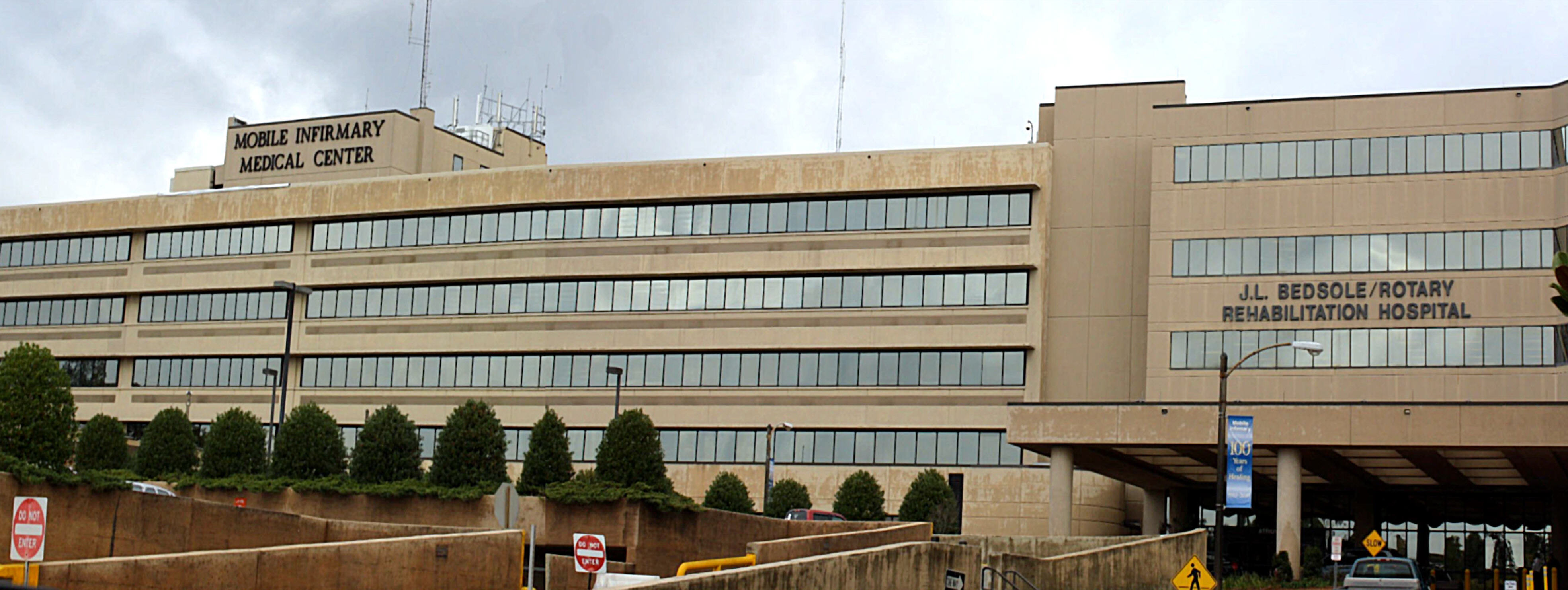
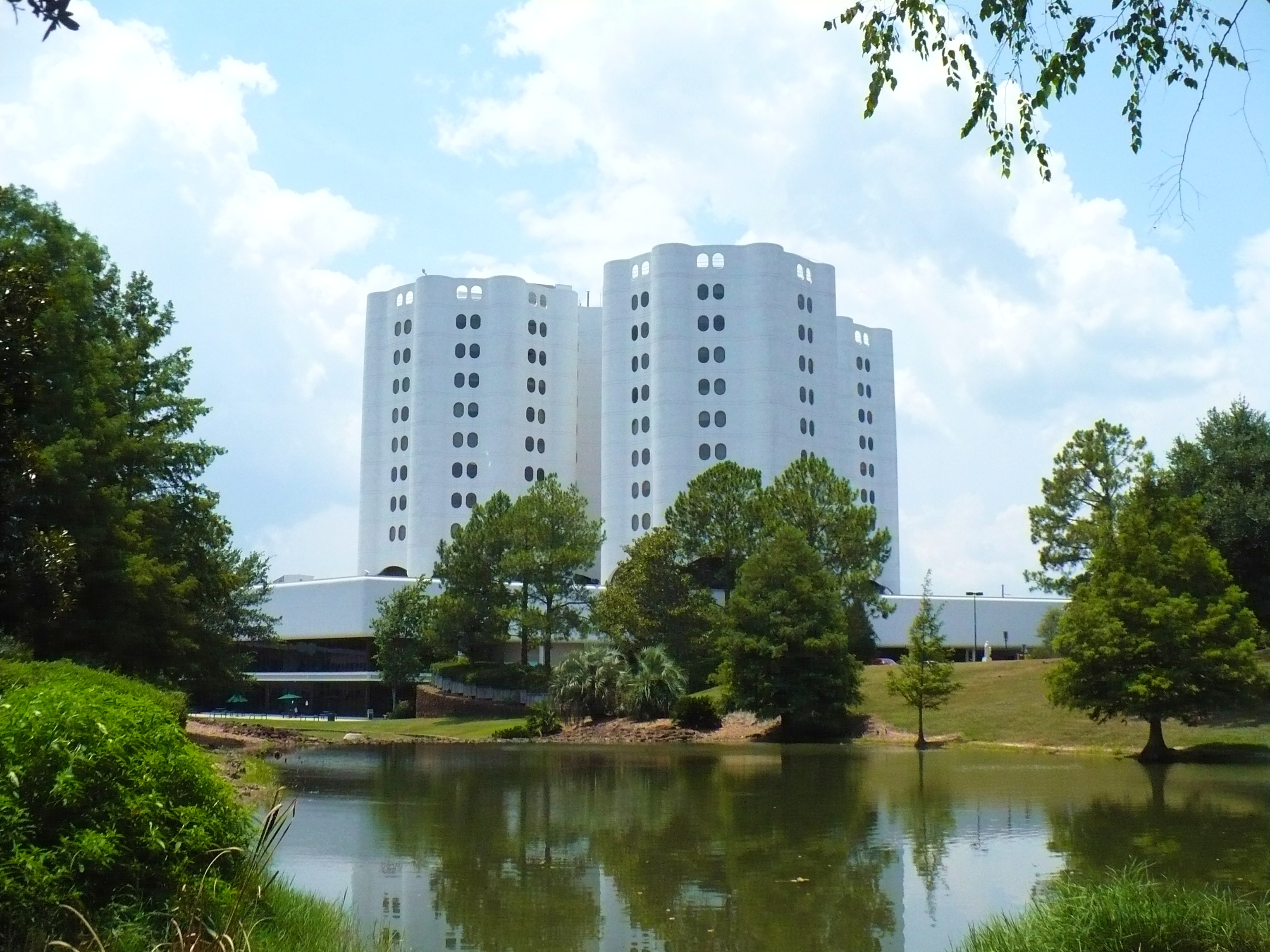 Mobile serves the central Gulf Coast as a regional center for medicine.
Mobile Infirmary Medical Center has 704 beds and is the largest nonprofit hospital in the state. It was founded in 1910. USA Health Providence Hospital, Providence Hospital has 349 beds. It was founded in 1854 by the Daughters of Charity of Saint Vincent de Paul, Daughters of Charity from Emmitsburg, Maryland. The University of South Alabama Medical Center has 346 beds. Its roots go back to 1830 with the old city-owned Mobile City Hospital and associated medical school. A teaching hospital, it is designated as Mobile's only level I trauma center by the Alabama Department of Public Health. It is also a regional burn center. Springhill Medical Center, with 252 beds, was founded in 1975. It is Mobile's only for-profit facility.
Additionally, the University of South Alabama operates the University of South Alabama Children's and Women's Hospital with 219 beds, dedicated exclusively to the care of women and minors. In 2008, the University of South Alabama opened the USA Mitchell Cancer Center Institute. The center is home to the first academic cancer research center in the central Gulf Coast region.
Mobile Infirmary Medical Center operated Infirmary West, formerly Knollwood Hospital, with 100 acute-care beds, but closed the facility at the end of October 2012 due to declining revenues.
BayPointe Hospital and Children's Residential Services is the only psychiatric hospital in the city. It houses a residential unit for children, an acute unit for children and adolescents, and an age-segregated involuntary hospital unit for adults undergoing evaluation ordered by the Mobile Probate Court.
The city has a broad array of outpatient surgical centers, emergency clinics, home health care services, assisted-living facilities and Nursing home, skilled nursing facilities.
Mobile serves the central Gulf Coast as a regional center for medicine.
Mobile Infirmary Medical Center has 704 beds and is the largest nonprofit hospital in the state. It was founded in 1910. USA Health Providence Hospital, Providence Hospital has 349 beds. It was founded in 1854 by the Daughters of Charity of Saint Vincent de Paul, Daughters of Charity from Emmitsburg, Maryland. The University of South Alabama Medical Center has 346 beds. Its roots go back to 1830 with the old city-owned Mobile City Hospital and associated medical school. A teaching hospital, it is designated as Mobile's only level I trauma center by the Alabama Department of Public Health. It is also a regional burn center. Springhill Medical Center, with 252 beds, was founded in 1975. It is Mobile's only for-profit facility.
Additionally, the University of South Alabama operates the University of South Alabama Children's and Women's Hospital with 219 beds, dedicated exclusively to the care of women and minors. In 2008, the University of South Alabama opened the USA Mitchell Cancer Center Institute. The center is home to the first academic cancer research center in the central Gulf Coast region.
Mobile Infirmary Medical Center operated Infirmary West, formerly Knollwood Hospital, with 100 acute-care beds, but closed the facility at the end of October 2012 due to declining revenues.
BayPointe Hospital and Children's Residential Services is the only psychiatric hospital in the city. It houses a residential unit for children, an acute unit for children and adolescents, and an age-segregated involuntary hospital unit for adults undergoing evaluation ordered by the Mobile Probate Court.
The city has a broad array of outpatient surgical centers, emergency clinics, home health care services, assisted-living facilities and Nursing home, skilled nursing facilities.
Notable people
* Jerry Carl – United States House of Representatives, U.S. representative * Rick Crawford (racing driver), Rick Crawford (born 1958) – racing driver * Anne Haney Cross (born 1956) – neurologist, section head of neuroimmunology at Washington University School of Medicine * George Washington Dennis ( – 1916) – former slave, turned entrepreneur and real estate developer in San Francisco, California; advocate for Black rights * Michael Figures (1947–1996) – American lawyer and politician who served in the Alabama Senate * Shomari Figures (born 1985) – U.S. representative from Alabama's 2nd congressional district * Thomas Figures (1944–2015) – first African American assistant district attorney and assistant United States Attorney * Flo Milli (born 2000) – rapper * Cale Gale (born 1985) – racing driver * Dorothy E. Hayes (1935–2015) – graphic designer, educatorDeMarko, Sharon (February 19, 1971). "Black Artists Graphics Displayed at Art Center". ''Pensacola News Journal''. p.&nbs11
€
12
– via Newspapers.com. * Vivian Malone Jones (1942–2005) – director in the United States Environmental Protection Agency, EPA, integrated the University of Alabama and was its first black graduate * Charles Keller (military), Charles Keller (1868–1949) – former U.S. Army Brigadier General and the oldest Army officer to serve on active duty during World War IIHistorical Vignette 079 – The Oldest U.S. Army Officer to Serve in World War II Was an Engineer
/ref>
/ref> * Antonio Lang (born 1972) – American former professional basketball player and coach * Anne Bozeman Lyon (1860–1936) – writer * Alexander Lyons (1867–1939) – rabbi * Bubba Wallace (born 1993) – racing driver * Paul Bearer, William Moody (19542013) professional wrestling manager known for his time in WWE under the name "Paul Bearer"https://web.archive.org/web/20091120140240/http://percypringle.com/biography.html
Sister cities
Mobile has nine Sister city, sister cities:See also
* List of people from Mobile, Alabama * List of tallest buildings in Mobile, Alabama * National Register of Historic Places listings in Mobile, Alabama * USS Mobile, USS ''Mobile'', 6 shipsNotes
References
Further reading
* Cox, Isaac Joslin. ''The West Florida controversy, 1798–1813: a study in American diplomacy'' (The Johns Hopkins Press, 1918online
* Gould, Elizabeth Barrett. ''From Fort to Port: An Architectural History of Mobile, Alabama, 1711–1918'' (University of Alabama Press, 1988) * Kinser, Samuel, and Norman Magden. ''Carnival, American Style: Mardi Gras at New Orleans and Mobile'' (University of Chicago Press, 1990.) *Kirkland, Scotty E. "Pink Sheets and Black Ballots: Politics and Civil Rights in Mobile, Alabama, 1945–1985." MA Thesis University of South Alabama * Pride, Richard Alan. ''The Political Use of Racial Narratives: School Desegregation in Mobile, Alabama, 1954–97'' (University of Illinois Press, 2002) * Thomason, Michael, ed. ''Mobile: the new history of Alabama's first city'' (University of Alabama Press, 2001)
External links
City of Mobile website
* {{Authority control Mobile, Alabama, Cities in Alabama Cities in Mobile County, Alabama Former colonial and territorial capitals in the United States County seats in Alabama Mobile metropolitan area Port cities and towns of the United States Gulf Coast Colonial United States (Spanish) French-American culture in Alabama Populated coastal places in Alabama 1702 establishments in New France Alabama placenames of Native American origin Populated places established in 1702